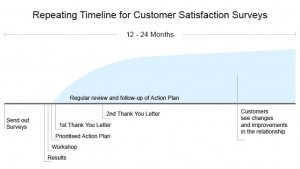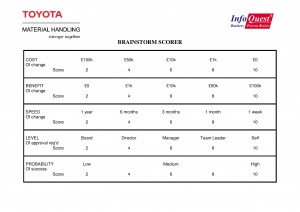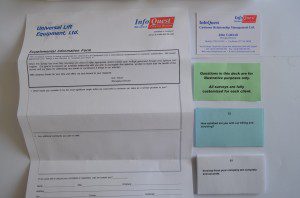The following tips can be applied to whatever method you use to gather feedback – whether you survey your customers using free on-line surveys; employ an agency to telephone them; or use InfoQuest and the box survey technique. There are no apologies for how basic they are (and none of us win friends by pointing out the obvious), but here goes.
Tip 1 – Do Something With The Feedback
As in any relationship, not listening to feedback, especially when you’ve asked for the feedback in the first place, is at best rude and at worst insulting.
In InfoQuest’s full-day’s post-survey workshops we work with the clients’ senior people, helping them come up with action plans, based on the survey report, to achieve the raison d’etre for doing the survey in the first place – that is “To increase profitable sales”.
However you do it, you need to do the same. My advice is to take a balanced approach when examining the responses. I’ll use the example customer survey report to help you. In sections 1 and 3 you’ll find top-level aggregated figures (and in section 3 you’ll also find benchmark scores comparing your results with the hundreds of thousands of other responses we’ve had since 1989). The top-level results are good for strategic aims – the helicopter view, if you like – to set corporate goals and check progress.
In sections 5 and 6 you will find the detailed, granular results, showing how each person answered every question. (Many agencies belong to the Market Research Society [MRS] or the European equivalent, ESOMAR. Both the MRS and ESOMAR have a code of conduct that doesn’t allow its members to report how individual people respond to surveys. This makes absolute sense in political opinion polling and B2C surveys, but in business-to-business customer satisfaction surveys, where people buy from people, it makes no sense whatsoever. InfoQuest’s staff don’t – and cannot – belong to the MRS and ESOMAR because we believe that it is so important that you are told exactly who said what. And we don’t hide the fact that we do this – in fact it’s on the home page of our website. I’m telling you this because, if you are using an agency, you may not have any granular results.) In sections 5 and 6 you will find out what different individuals need from you to facilitate a better business relationship. Each customer will be different, and this level of detail allows you to develop your 1 to 1 working relationship.
Continuing with the balanced approach, most people at this stage are looking for issues to address. They are the natural “problem solvers” (they’ve probably got something about problem solving on their C.V.’s). But to get the most from your customer satisfaction survey you need to looking at those customers who love you as well (recently I’ve had a lot of clients who have been in the position where most of their customers love them).
To maximise the opportunities, where you and your team, usually over a long period of time, have worked hard and grown a loyal and positive group of clients, you need to be collecting references and referrals, getting more work, a bigger share of wallet, case studies for white papers and industry publications. And better margins. At a workshop I ran in the summer heat in Chicago, the client’s team decided on a three-pronged approach to increase margins – a straight-forward price increase where customers recognised the value of the relationship over and above the piece-part prices of the equipment they were buying; a reduction in terms that were being offered; and a change in policy which would allow them to split up large orders, so that they could manufacture in batches and, most importantly, invoice in batches rather than have to wait for the entire order to be made.
Your ideas need to be prioritised and then implemented. We use the Brainstorm Scorer to prioritise the ideas. But it’s up to you to implement them.
And this is where increased responses come from. If your key accounts, business partners and clients see that you are acting on their feedback, then the next time that you ask for their input they won’t be so sceptical and will be much more forthcoming. As you know, InfoQuest has an average response rate of just over 70% from worldwide, hard-to-reach customers. It’s one of our key value propositions – particularly when compared with the 5% to 15% response rates that web-surveys achieve. And we are always delighted when our clients have acted on the feedback because it makes repeat surveys not only easier to validate (customers say “yes” to the survey much more readily) but also the response for the next rate is nearly always significantly higher.
Tip 2 – Don’t Ask Dumb Questions
So, you’ve told the customer how important they are to you and that you need their feedback. Here comes the survey. Wait for it. Hang on! Here it is!
“Who are you?”
If I’m such an important customer then you know who I am. And, by the way, you contacted me – not the other way round.
“What is your address?”
Come on! You’ve been delivering to us for years. That and the invoicing address is something you do get right, most of the time.
“What do you currently buy from us?”
Obviously not enough, based on the last conversation I had with the new sales rep. They certainly didn’t make me feel like a valued account.
We’ve all seen customer satisfaction surveys that begin like this. This is not the correct way to treat a valued customer. They know a lot about you – they’ve been a client, in receipt of your product or service for years – so treat them as someone you’ve had a relationship with for many years. Because that’s who they are.
If in doubt, put yourself in their shoes before the survey goes out. Check to see if you’d feel insulted or offended in any way.
Asking dumb questions will harm your response rate and can easily lead a somewhat dissatisfied customer to start looking for an alternative supplier.
Client satisfaction surveys should always be good PR. Listening respectfully, hearing what has been said, feeding back what you’ve found out and taking the appropriate action to improve the relationship – because you care – will ALWAYS be good PR.
There are eleven pages of sample B2B customer satisfaction survey questions on the Downloads page to give you ideas of what you could be asking. With an InfoQuest survey you can pose up to 60 questions and statements without affecting our 70% average response rate.
Tip 3 – Make it Quick
When we say “make it quick” we’re not talking about asking just one question. The Net Promoter Score is a ridiculous concept from an operations point of view. No, we’re talking about telephone surveys.
You get the call. You are a bit reluctant. You’ve got a visitor waiting for you in reception and a meeting later in the day that you need to prepare for, and the very nice person on the phone has convinced you that it will only take five minutes.
After asking some dumb questions, like what and how much do you buy, which they should have known before they rang you (see Tip 2) if you really are a valued customer, they start reading through their script. You’re trying to concentrate on what they’re saying – but you’re also looking at your diary, which you were trying to update before they phoned.
After 10 minutes there is a 50% chance that you’ve had enough and ended the call prematurely.
After 15 minutes there is a 75% chance that you’ve put the phone down on them.
After 20 minutes you hope your boss doesn’t find out because, clearly, you don’t have enough proper work to occupy your day, your time management is awful, the person in reception has walked out and you’re not going to be prepared for that meeting.
If you are intent on running a telephone-based customer satisfaction survey you must run a role play first, reading through the script aloud and allowing for the odd “can you please say that again?”
Be prepared for respondents that are going to ask the question “How long will this take?” and be prepared for a significant number of declines. Company policy. Too busy. No, sorry.
However, there is another way.
The InfoQuest box takes, on average, just 5 minutes.
Timed studies show that, from a standing start, with no prior experience, the average person can process between ten and twelve questions and statements in the first minute.
Tip 4 – Two Thank You Letters
This tip is definitely not theoretical. I was shown it by one of our long-standing clients a few years ago. This client, a research agency, has a relatively small number of customers. We’ve been conducting their customer satisfaction surveys every 18 – 24 months for a long time, and we were seeing the same names cropping up time after time (by the way, I’m going to cover survey fatigue in the next tip). InfoQuest’s survey box does have a novelty factor, which is bound to have an influence on our response rates (currently averaging just over 70%) but, as with all novelties, once you’ve seen it and done it………….
Well, a few years ago this particular client started to see response rates of 90%. Obviously delighted for them, we asked if they were doing anything different. It turned out that their CEO, Dr Susan Sharland, had taken it upon herself to write not one but two thank you letters to her customers.
The first, sent shortly after they’d received the report (and using the clean customer data with all the corrections that we provide as a matter of course with all our survey reports) gave the highlights of their survey and explained the main points that Susan and her team were going to address.
The second letter (which is more tailored to individual customers) is sent out three months later. It says what has been done to change the way they operate, based on the customer feedback, and what is yet to be achieved.
With these two letters Susan showed her customers that her company was listening; that the customers (and their feedback) were important; and that they were acting on the feedback that they’d been given (see Tip 1).
Now, normally a customer has to experience a “new, better way of doing things” at least three times before they accept that it’s not a quirk of fate or an accident that billing or quotations or pricing or communication or planning or sales order processing or whatever has got better. But with a letter, in fact two letters, from the senior person, this recognition is almost immediate.
It also binds the relationship. The CEO is no longer a figure-head, some remote person doing deals in the city. They’ve become not just a real person but also a friend and an ally.
And you know what? This really inexpensive piece of marketing (if you want to be sceptical about it, which you shouldn’t be) not only brings a higher survey response rate to future surveys (when those who didn’t respond last time receive these two letters they see the worth of responding next time) but it also brings in more business. Think about it. When you are placing orders on your suppliers, given the choice wouldn’t you prefer to do business with the company that clearly shows that they care about you and that all-important one-to-one business relationship?
Whenever I run a post-survey workshop with a client’s senior team I recount this story towards the end of the session. Some of my clients take heed, and others, as it their right, don’t. But I can always identify those who do by the improved response rates on their subsequent surveys.
Two years ago we took on a new client. It was a tough project, with lots of languages and a high proportion of hard to reach customers – based in gold, silver and copper mines, seaports and metal foundries throughout the world. Their first survey had a poor response rate for us (I’ve just looked it up, it was 67%). This year we repeated their survey, and they got a 78% response rate from the same hard to reach customers. How? They’d sent out two Thank You letters.
Tip 5 – International Language Etiquette
There are whole books dedicated to this subject, but here the subject is increasing or improving customer satisfaction survey response rates, specifically in B2B.
The most straightforward approach when conducting international surveys is always keep in mind the idea that what you do should never be bad for PR (public relations). And that the best people to advise you on language nuances are your own key account managers (KAMs), as they are the people who know your target audience.
Let me give you two examples of what can affect response rates.
In South Africa, particularly in the engineering and mining industries, if you let the customer choose to have the survey in either Afrikaans or English (check with the KAM first) you will get a better response rate.
In The Netherlands, Holland, Belgium and Luxembourg again you need to seek advice from you KAMs. We nearly always use English in this region, having found long ago that to use Dutch or Flemish or French can be insulting to some people, particularly if the survey is coming from an English-speaking client (say, British or American). Put simply, and I’m trying not to offend anyone here, people in the Benelux countries know that their English is nearly always as good as if not better than the English of us native-language speakers. However, there are always exceptions to the rule, and we have had outright refusals because our client has assumed. You should always check.
If you treat your most important customers as individuals, take guidance from your KAMs (who should hold the key to the relationship) and keep good PR in mind at all times, you shouldn’t go too far wrong.
Note: you should be asking your KAMs for Share of Wallet figures for all key accounts prior to the survey, so ask about language at the same time.
Tip 6 – Don’t be Too Frequent
Remember we are talking here about business to business customer satisfaction surveys, where the typical medium to large organisation has between 50 and 500 key accounts (and if you do the sort of analysis we cover in http://www.infoquestcrm.co.uk/your-customers/ you’ll only have a proportion of that).
It’s not like you can survey customers A to D on the first occasion, and then E to J on the next, and so on.
You need a big enough group and a high enough response rate to give you sufficient feedback for you to get your teeth into.
So don’t burn your customer list by surveying them too frequently.
There is no hard and fast rule as to what the frequency should be – we simply recommend that it’s somewhere between 12 and 24 months.
What the customer needs to see is that you listened last time and you acted on their feedback (see Tips 1 and 4). Usually they need to experience the new, better way of working three times before there is a subliminal acceptance that you have improved.
So, for some businesses, 12 months might be too soon. The frequency of repeat orders might only be every 5 or 6 months, so to experience the full cycle of order enquiry right through to invoicing three times could easily be 18 months or more.
The customer, or rather the person you want the feedback from, is unlikely to help you by returning the survey if they feel that there is nothing in it for them, and they could well feel that way if you keep asking for their input without demonstrating clearly that yours is a two-way relationship. It’s called ‘survey fatigue’.
As a foot note, it’s worth adding that for you, the client, it can be difficult knowing what it is that you are measuring if you conduct the surveys too frequently. Is the customer’s perception based on how things were prior to a recent improvement to the way you do things, or is it based on how things are now?






